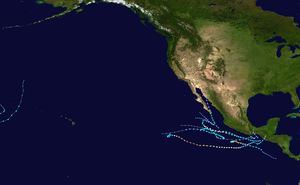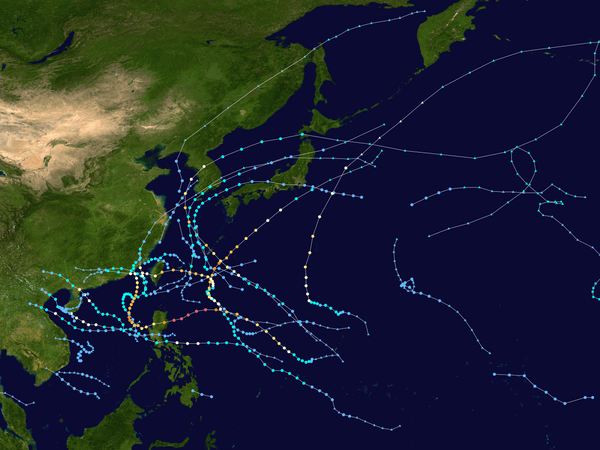Tropical Storm Omeka
Tropical Storm Omeka was the latest forming Eastern Pacific named storm since reliable records began in the 1960s. The storm was part of the 2010 Pacific typhoon and hurricane season. On December 18, 2010, the Central Pacific Hurricane Center (CPHC) began monitoring a subtropical cyclone near the International Dateline for possible tropical cyclogenesis. Over the following two days, the system tracked southwestward, entering the Western Pacific basin. It then began to transition into a tropical cyclone. Shortly before crossing the dateline on December 20, the CPHC assessed the system to have become a tropical storm. The storm was assigned the name Omeka several hours later as it moved into the CPHC's area of responsibility – which is from 140°W to the International Dateline. Upon doing so, Omeka attained its peak intensity with winds of 60 mph (100 km/h). Later on December 20, wind shear in the region increased, causing the system to weaken. By December 21, the center of Omeka was devoid of convection and dissipated on the next day. Omeka brushed Lisianski Island with no damage.
| Tropical storm (SSHWS/NWS) | |
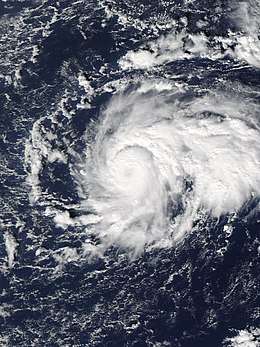 Omeka as a subtropical storm on December 19, prior to the system's tropical transition | |
| Formed | December 18, 2010 |
|---|---|
| Dissipated | December 23, 2010 |
| (Extratropical after December 21) | |
| Highest winds | 1-minute sustained: 60 mph (95 km/h) |
| Lowest pressure | 997 mbar (hPa); 29.44 inHg |
| Fatalities | None reported |
| Damage | None |
| Areas affected | Northwestern Hawaiian Islands |
| Part of the 2010 Pacific hurricane and typhoon seasons | |
Meteorological history
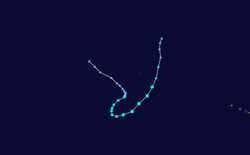
The origins of Omeka were from an extratropical cyclone in the western Pacific Ocean. The storm tracked southeastward near the International Dateline, and by December 18 it transitioned into a kona storm and soon into a subtropical cyclone.[1] A large, sprawling system, little development was initially expected to take place as the storm moved towards the southwest.[2] As the low moved over warmer waters, the cyclone was able to maintain an area of deep convection near its center. According to the CPHC, the system was nearly fully tropical early on December 19 as it moved west of the dateline.[1][3] However, the Joint Typhoon Warning Center (JTWC) considered the low to be fully subtropical as a cold-core was present over the center of circulation.[4] At this time, the storm had an eye-like feature, and attained its peak strength with winds of 60 miles per hour (100 km/h) and a barometric pressure of 997 millibars (29.4 inHg).[1] Later on December 19, the Japan Meteorological Agency (JMA) classified the system as a tropical depression as the low turned towards the southeast.[5] Early on December 20, the JMA issued their final advisory on the depression as it moved east of the dateline and reentered the CPHC's area of responsibility.[1][6]
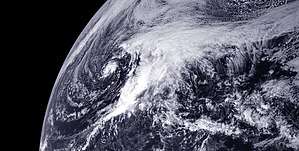
Already classifying it as a tropical storm, the Central Pacific Hurricane Center (CPHC) issued their first advisory on the system at 0900 UTC on December 20, at which time it was situated roughly 505 miles (815 km) south of Midway Island. Upon issuing this advisory, they designated the system as Tropical Storm Omeka, the first named storm of the Central Pacific season.[1][7] The storm generally tracked towards the northeast, in response to a mid-level low to the west, throughout the remainder of its existence. Traversing an area of decreased sea surface temperatures and increasing wind shear, Omeka quickly weakened to a minimal tropical storm later on December 20, with winds of 40 miles per hour (65 km/h).[1][8] Intermittent bursts of convection allowed the system to maintain gale-force winds through December 21; however, persistent shear finally took its toll later that morning. Between 0700 and 0800 UTC, Omeka brushed Lisianski Island.[1][9] Around 0900 UTC, the CPHC issued their final advisory on Omeka, as it transitioned into an extratropical cyclone roughly 280 miles (450 km) east-southeast of Midway Island, near Lisianski Island.[10] Omeka's extratropical remnant dissipated on December 23.[1]
Impact and records
On December 21, the center of Omeka brushed Lisianski Island, with winds of 40 miles per hour (65 km/h).[9] However, no tropical storm watches or warnings were issued since the CPHC anticipated weakening prior to the storm passing the island.[9] On December 20, Omeka crossed the International Dateline into the northeast Pacific, becoming the first tropical cyclone to do so since Tropical Storm Wene in 2000,
At the time, Omeka was judged to have existed in the northeast Pacific later than any other storm since the 1960s, when reliable records begin in the basin.[1][7][11][12] However, according to the CPHC's database, there are two possible tropical cyclones in 1903 and 1904 which developed on December 23.[13] In addition, even though it did not strengthen into a tropical storm, Tropical Depression Nine-C of the 2015 Pacific hurricane season formed later in the calendar year than Omeka, forming on December 31, 2015 and dissipating the next day.
Omeka was the first December storm in the Central Pacific since Tropical Storm Paka in 1997.[1][14] Throughout 2010, the entire Pacific Ocean experienced record-low tropical cyclone activity due to a strong La Niña.[15] Since Omeka was the first storm in the Central Pacific during the year, it marked the latest start to a season since reliable records began, excluding seasons with no storms.[1][12][16]
See also
- Kona storm
- 1951 Hawaii cyclone
- Tropical Storm Haiyan (2007)
- 2006 Central Pacific cyclone
- List of off-season Pacific hurricanes
References
- Timothy A. Craig, Samuel H. Houston; Central Pacific Hurricane Center (March 8, 2011). Tropical Storm Omeka (PDF) (Tropical Cyclone Report). Central Pacific Hurricane Center. Retrieved June 9, 2019.
- Samuel H. Houston (December 18, 2010). "Special Tropical Weather Outlook". Central Pacific Hurricane Center. Archived from the original on December 18, 2010. Retrieved December 20, 2010.
- Samuel H. Houston (December 19, 2010). "Tropical Weather Outlook". Central Pacific Hurricane Center. Archived from the original on December 19, 2010. Retrieved December 20, 2010.
- "Significant Tropical Weather Outlook". Joint Typhoon Warning Center. December 18, 2010. Archived from the original on December 19, 2010. Retrieved December 20, 2010.
- "Tropical Disturbance Summary". Japan Meteorological Agency. December 19, 2010. Archived from the original on December 19, 2010. Retrieved December 20, 2010.
- "Tropical Disturbance Summary". Japan Meteorological Agency. December 20, 2010. Archived from the original on December 20, 2010. Retrieved December 20, 2010.
- Timothy A. Craig (December 20, 2010). "Tropical Storm Omeka Public Advisory One". Central Pacific Hurricane Center. Retrieved December 20, 2010.
- Raymond M. Tanabe (December 20, 2010). "Tropical Storm Omeka Discussion Three". Central Pacific Hurricane Center. Retrieved December 21, 2010.
- Raymond M. Tanabe (December 21, 2010). "Tropical Storm Omeka Discussion Four". Central Pacific Hurricane Center. Retrieved December 21, 2010.
- Samuel H. Houston (December 21, 2010). "Tropical Storm Omeka Public Advisory Five (Final)". Central Pacific Hurricane Center. Retrieved December 21, 2010.
- Central Pacific Hurricane Center. "Previous Tropical Systems of the Central Pacific". Archived from the original on 23 February 2007. Retrieved 2007-02-23.
- National Hurricane Center; Hurricane Research Division; Central Pacific Hurricane Center. "The Northeast and North Central Pacific hurricane database 1949–2019". United States National Oceanic and Atmospheric Administration's National Weather Service. A guide on how to read the database is available here.
- "Tropical Cyclones During the Years 1900 - 1952". Central Pacific Hurricane Center. May 4, 2007. Retrieved December 20, 2010.
- Samuel H. Houston (January 2, 2011). "Tropical Weather Summary for the Central North Pacific". Central Pacific Hurricane Center. Archived from the original on September 15, 2011. Retrieved September 15, 2011.
- James L. Franklin; Lixion A. Avila (December 1, 2010). "2010 Pacific Hurricane Season Summary". Monthly Tropical Weather Summary. National Hurricane Center. Retrieved July 9, 2013.
- Samuel H. Houston; Robert Ballard; Kevin Kodama; Raymond M. Tanabe (December 1, 2010). "Tropical Weather Summary for the Central North Pacific". Central Pacific Hurricane Center. Archived from the original on December 20, 2010. Retrieved December 20, 2010.
